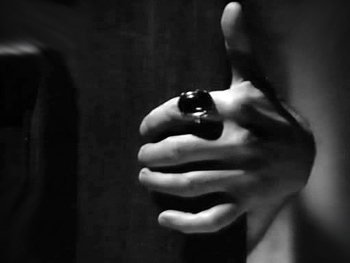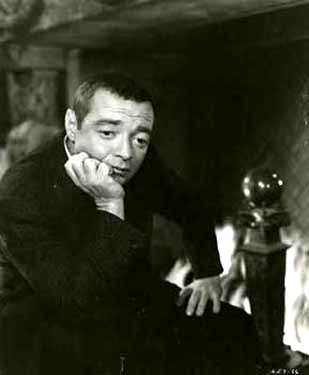|
|
Reviewed by Glenn Erickson
Unavailable since the days of VHS tapes and remembered by generations of film and TV fans as a superb exercise in horror, The Beast with Five Fingers still holds up as a fun spook show that demonstrates what can be done with some smartly-handled visuals and a high-caliber performance. In this case the third-billed Peter Lorre elevates a somewhat goofy original concept to near-classic status.

'Twenties cinema artist and film buff Robert Florey is strongly associated with the horror genre, even though he was bumped from the directorship of the original Frankenstein after completing a great deal of preparation. Perhaps temperament or studio politics had a hand in his career, for he directed The Marx Brothers and a string of successes, yet never achieved first-rank director status. He did appreciate the genius of Peter Lorre, however, having already directed the actor in the marvelously creepy Columbia thriller The Face Behind the Mask. That morbid little gem is still unavailable, and begging for a disc release.
The Beast with Five Fingers is set in a studio-created Italy. The wealthy, partly paralyzed Francis Ingram (Victor Francen) surprises his family when he announces that he's changed his will to leave his large villa and fortune to his nurse Julie Holden (Andrea King). Julie isn't sure she wants the money, but most everyone else responds selfishly. Francis's blood heirs Arlington (Charles Dingle) and his son Donald (John Alvin) make plans to dispute Ingram's will, convinced that Julie has exerted undue influence. Julie's boyfriend Conrad Ryder (Robert Alda) asserts that Francis is of sound mind, but he already makes his living bilking tourists into buying 'art treasures', and would like nothing better than to marry Julie and share her inheritance. Particularly upset is Francis's secretary Hilary Cummins (Peter Lorre), an astrology-obsessed researcher who begs for more time with the old man's books, to make a breakthrough proving the reality of the supernatural. Francis is insistent that Hilary be cut off and sent away. Not much later, Francis is killed in an accident. Hilary becomes frantic, claiming that he's being haunted by his ex-employer's severed hand. Police Commissario Ovidio Castanio (J. Carrol Naish) is on the case immediately, and is confounded when a strangulation murder occurs. Nobody believes Hilary until Ingram's body is exhumed -- and his left hand is found to be missing!

Curt Siodmak's screenplay, from a story by William Fryer Harvey, uses a standard but sturdy setup for a supernatural whodunnit. Everybody is a suspect, even the ostensibly innocent Julie. Events go pretty much as expected until Hilary Cummins' nightmarish scenes kick in, at which time the combined talents of director Florey, the special effects department and Max Steiner's dynamic music raise the chill factor to the ceiling. Peter Lorre takes the effect the rest of the way, finding a dozen ways of appearing haunted, shaken and finally terrorized by a horrifying hand crawling under its own power. A shocking sight for the 1940s, the hand has been raggedly sawed or chopped off - the stump of a bone is even visible in the wound.
Lorre's reactions to this apparition are priceless. There aren't many actors as woefully underused as Lorre -- as he seems easy to cast, his problem can only be that average stars would fear being upstaged by him. He's a standout in almost every movie he ever appeared in, and he made a lot of otherwise iffy shows well worth seeing.
The severed hand doesn't just crawl about, like "thing" in the film version of The Addams Family. It shows up in crazy places, like a sealed safe. At one point Hilary feverishly nails it to a block of wood, adding a fillip to the film's 'squeamish' factor. Detached, demonic hands eventually became almost as common as "living" ventriloquist's dummies; the problem was usually in the methods used to visualize them. CG images make it too easy to create an ambulatory severed hand, but the solutions in earlier pix were often inadequate. The hand that threatens Christopher Lee in Doctor Terror's House of Horrors is a phony rubber item that folds awkwardly as it moves, and has a prominent seam line that betrays that its origin was a latex mold. The same wind-up item appears to make a rubbery comeback in the subsequent And Now the Screaming Starts. The hand in Bert I. Gordon's Tormented is a real hand unconvincingly slotted into one or two shots via a crude traveling matte, and suffices to shock small children. Neither did Oliver Stone's 1981 The Hand follow Beast's good example.
In Florey's picture clever blocking allows the hand to be seen on surfaces where (through a makeup effects trick) the attached arm can be hidden, or simply lost in darkness. This works very well when the phantom hands play the piano. Only once do we see a fake wind-up hand, for only a couple of seconds. In some scenes it appears to be dead, only to become frighteningly alive when it once again confronts Peter Lorre. Again, it's all a matter of presentation -- Florey knows when showing the hand will make a maximum impact, and Lorre's goggle-eyed reactions make it real. It's called stylized moviemaking, of which Robert Florey occasionally proved himself a master.

Andrea King hailed from France as well, and had minor roles in Warner pix until 1945 or so. She'd later do excellent work in movies that didn't boost her career, like Mr. Peabody and the Mermaid, Ride the Pink Horse and the infamous Red Planet Mars. Robert Alda is just plain dull, so much so that we don't even wonder why such a mercenary jerk as Conrad is the story's "by default" leading man. By this time Victor Francen was playing mostly the same kind of roles, and he's cast to type. And it comes as no surprise that J. Carrol Naish steals scenes as the garrulous, amusingly intrusive policeman. Naish had once played ethnic baddies in practically every Warners Pre-code programmer; here he shows a fine comic touch. As if convinced that the Production Code wouldn't tolerate serious horror content, The Beast with Five Fingers sidesteps supernatural explanations. It makes fun of its own concept in Naish's unabashedly comic concluding scene that breaks the fourth wall. Horror fans don't resent this, but they also tend to ignore it in favor of the show's earlier, frenzied horrors.
The Beast with Five Fingers was a thankless project for Robert Florey. Horror pictures were out of favor (Warners didn't make another for the entire decade) and many critics dismissed the show as ludicrous. I didn't catch up with it until I was almost thirty, and I can't remember why - it showed on L.A. TV stations almost as frequently as did Them! But I distinctly remember hearing a number of people (civilians, not horror crazoids) naming it as the movie that had them hiding their eyes and having nightmares when they were kids. It's an ideal choice for a fun, non-disgusting horror thriller - that could still give impressionable children nightmares.
The Warner Archive Collection DVD-R of The Beast with Five Fingers is overdue on the disc format. The word on the street is that it posed tougher-than normal transfer problems. The visuals are still quite good but not quite as snappy as some other 1946 films in the WAC collection; it's possible that an original negative hasn't survived for this particular title. The good news is that the soundtrack is very good. Without hearing any details, I've been told that Warners had a heck of a time obtaining (or restoring?) acceptable audio on Beast, and had to do a lot of work on the track. Judging from what I hear, that issue has been addressed and resolved.

An original trailer is present. As is usual with fantastic films older than 1970 or so, a good ad campaign makes all the difference. We see the scare value in the picture and even get a glimpse of the 'horror hand': every fan of creepy cinema must have come running.
On a scale of Excellent, Good, Fair, and Poor,
The Beast with Five Fingers rates:
Movie: Very Good +
Video: Good
Sound: Very Good
Supplements: Trailer
Deaf and Hearing Impaired Friendly?
N0; Subtitles: None
Packaging: Keep case
Reviewed: October 28, 2013

DVD Savant Text © Copyright 2013 Glenn Erickson
See more exclusive reviews on the Savant Main Page.
Reviews on the Savant main site have additional credits information and are often updated and annotated with reader input and graphics.
Also, don't forget the
2011 Savant Wish List.
T'was Ever Thus.
Return to Top of Page
|


